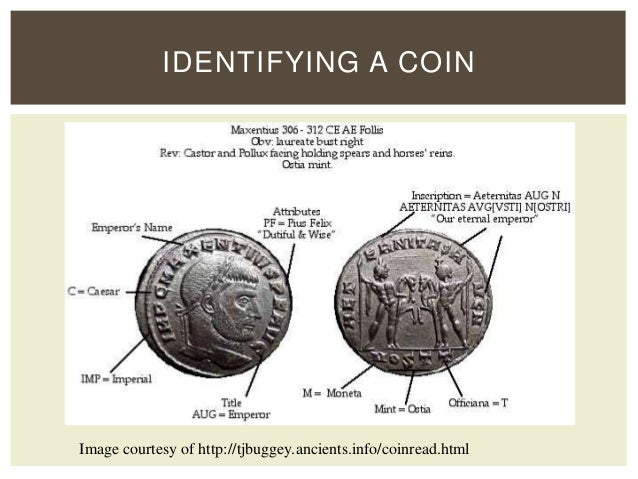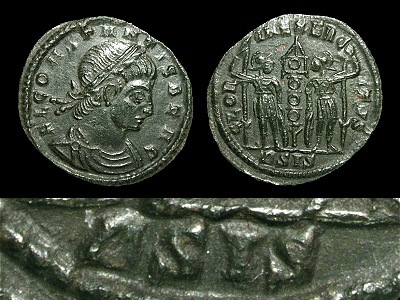

Collecting Ancient Roman Coins Part IV: Identify
How to identify the Roman coins. The coins
From Augustus to Diocletian 27 BC-286 AD.
It is very important that after you properly identify the issuer of the coin and you date it correctly, to identify the nominal of the coin. Unlike the modern times, when the value of the coin is clearly stated on it, in ancient times, the value was known by the weight and the diameter of the coin.
Here are the main coins of the period 27 BC-286 BC
GOLD COINS
Aureus - a coin made from gold, as its name states. It was first minted around 210 BC but it was an exotic coin, with a high value. The republican pieces are usually rare.
From Augustus, it was a gold coin of high purity, around 23 k, and a weight of 7.9-8 gr. and a diameter of 19-21 mm. It had a value of 25 silver denarius. On one side, the head of the emperor appears or, more rarely, a member of his family. On the other side, different scenes are presented.
From the time of Nero, the weight drops from 64 AD to around 7.6-7,7 gr. and from the second century AD to around 22 k of gold. From the time of Septimius Severus and his son Caracalla the weight was around 6,5-7 gr. In the third century the weight was very different from emperor to emperor, in the context of the crisis. The weight went from 3,5 to 5,5 gr. Diocletian also minted some aureus around 5,4 gr.
Shop now for $10 off your first Purchase
The aureus is a very rare coin. A normal value for this coin is around 3000-4000 $. In some cases, like a rare emperor or a rare reverse, the coin can easily go over 10.000 $. Usually, these coins have circulated quite a bit and a good coin is not rare, like a VF. A UNC, however, is very hard to find.
Quinarius aureus - the golden half. It represented ½ of an aureus and also half of its weight. It is a rare coin, seldom seen in circulation. It was minted on rare occasions. It weights around 4 gr. and has a similar look as the aureus. From the third century, because of the more and more light aureus, it disappeared from circulation.
These coins are very rare and expensive, even more than the aureus.
SILVER COINS
Denarius is the standard coin in the roman system. It is made from silver and that’s why it is sometimes named as denarius argenteus. It values 1/25 from a gold aureus and 16 asses.
In the republican time, it was first minted around 210 BC. In the beginning, it valued only 10 bronze asses, thus named denarius (from decem, which means ten).
It weighed around 4,4 gr. in the beginning. Augustus minted denarius at around 3,9 gr. From 64 AD, Nero minted them around 3,5 gr. In the second century, the coin dropped to around 2,5-3,3 gr but pieces of 3,8 are not unusual.
The diameter was around 17-18 mm for the denarius in the first century. At the beginning of the second century, it was around 18-20 mm. Starting with the first part of the reign of Septimius Severus, it was a more thick and small coin, around 15-17 mm but from the second part of the reign, after 202, it became thin and large, around 18-21 mm.
The quality of the silver was around 90-93 %, in the beginning. From the reign of Trajan, 98-117, it was around 70-80 %. Septimius Severus minted denarius at around 50-70 %. Sometimes, these coins were made from bronze and only silver plated.
In the third century, in the context of inflation, its value dropped and after 238 it can rarely be seen in circulation.
This coin is one of the most common for the Roman Empire. It was minted in large quantities. Most of them are valued today at 20-50 $ a pieces of medium condition and not so rare. In some cases, for example a rare emperor or rare reverse can have a high value, around 1000 $ or even higher. Usually the Consecratio theme or the family coins, with more than one member are rare.
Also, this coin is hard to find in decent condition. Even a VF is sometimes hard to find, because these coin circulated for a long period of time. A XF is almost a dream.
Quinarius argenteus represents half a denarius. It is made from silver and has a weight of half this coin, around 1,2-1,7 gr. It is similar to the denarius. It is a very rare coin, hard to find and usually expensive.
Antoninianus has a value of 2 denarius. It was introduced in 215 and as a distinctive feature, the emperor’s head has a radiate crown, while the empress has a lunar crescent over her shoulders. It had a diameter of 23-25 mm and initially a weight of 5,5. The silver content was only 50 %.
After 238, it lost weight, to around 4,5. After 251 it became a bronze coin, with only 3-5 % silver. Also, it was light, around 3 gr. Even so, light pieces can be found. Aurelianus, 270-275, tried to improve this coin but failed. It disappeared from circulation after Diocletian reform.
BRONZE COINS
Sestertius is a quarter of a denarius. It was originally made from silver but Augustus mints this coin in bronze. It usually bears the mark HS as a symbol of value.
It has a diameter of 25-40 mm, and a weight of 25-27 gr. Usually, it has superb scenes on the back, because of the large available space. In the third century, it started to lose value and weight, after the second half of the century it disappeared from the market.
Usually, this coin is hard to find. A fine example can go from 100 to 300 $. Cheaper pieces can be found. Also, depending on the back, they can be much more expensive.
Some of the most spectacular pieces are the ones with buildings. For example the one dedicated by Nero in honour of his Ostia harbour.
Dupondius was a coin made from orichalcum, a bronze alloy. It weights around 13 gr. and the diameter can vary in size. It was equal to ½ sestertius or two asses. After 64, its distinctive mark was the radiate crown that stands on the emperor’s head.
These coins are scarce, yet decent pieces can be found.
As is the basis of the Roman currency. It was a unit made from bronze. During the republican time, it had different weights, from 1,5 kg (aes rude), being minted as ingots. It soon lost its weight and became a coin (aes grave) with a weight of 327 gr. In 89 BC, the weight was considered equal to one ounce (aes uncial). Augustus minted asses at around 10-11 gr. It was made of bronze. The first century pieces are simple and inexpressive but usually rare. The second and third century pieces are common.
The price of this coin can vary. It is very hard to find a good quality piece.
Semis was a measure unit ever since the republican times. It is a rare coin, very rarely minted. It was half of an as, as the name states (semis=half).
Quadrans was ¼ of an as, as the name states (quadrans=quarter). Also a rare coin. Was minted ever since republican times. In the imperial time, it was rarely minted. Lots of collectors have the tendency to take the fake denarii, made from bronze, as quadrans. The main difference is the style. The quadrans have a slight negligent aspect.
It was the less valuable coin in circulation. Cicero uses the word quadrantaria to describe something very cheap
Vasilita Stefan
Was this article helpful?
1 person found this article helpful
0 thoughts on “How to identify roman coins”